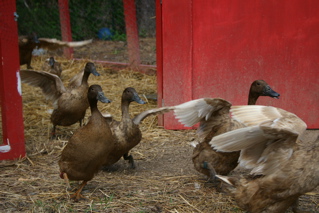
Photo by Kathy
I believe the duck revolution has been quashed.
All day Friday, Eddy and Patsy squawked at each other. When we let them out in the yard Friday evening, Patsy tried to round up the flock and make them go where she wanted. Except for Sybil (who quacked in agreement), no one paid any attention. They went right on hunting for bugs where they were.
That is probably when Patsy’s plans began to unravel. Without popular support, no revolution can succeed. Saturday saw only the occasional argument. On Sunday morning Eddy, asserting her dominance again, led the flock into the grazing pen without my orders. It has been quiet since. Relations in the flock appeared to have returned to normal.
I would make another snide comment about the dismal lack of anatine intelligence, but it occurs to me that this matter was settled after only a week, with no bloodshed and (as far as I can tell) no hard feelings on either side. Meanwhile Israelis and Palestinians, Catholics and Protestants, Sikhs and Hindus, Muslim and African Sudanese have been at each other’s throats for decades, centuries, millenia. I’ll defer judgment on anatine pacifism until I see how our ducks respond to a second flock, but having read the newspaper this morning I’ll keep mum on their intelligence as well.